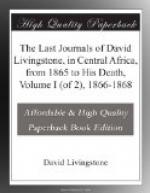14th April, 1866.—To-day we succeeded in reaching the Rovuma, where some very red cliffs appear on the opposite heights, and close by where it is marked on the map that the Pioneer turned back in 1861. Here we rested on Sunday 15th.
16th April, 1866.—Our course now lay westwards, along the side of that ragged outline of table-land, which we had formerly seen from the river as flanking both sides. There it appeared a range of hills shutting in Rovuma, here we had spurs jutting out towards the river, and valleys retiring from a mile to three miles inland. Sometimes we wended our way round them, sometimes rose over and descended their western sides, and then a great deal of wood-cutting was required. The path is not straight, but from one village to another. We came perpetually on gardens, and remarked that rice was sown among the other grain; there must be a good deal of moisture at other times to admit of this succeeding: at present the crops were suffering for want of rain. We could purchase plenty of rice for the sepoys, and well it was so, for the supply which was to last till we arrived at Ngomano was finished on the 13th. An old doctor, with our food awaiting, presented me with two large bags of rice and his wife husked it for us.
17th April, 1866.—I had to leave the camels in the hands of the sepoys: I ordered them to bring as little luggage as possible, and the Havildar assured me that two buffaloes were amply sufficient to carry all they would bring. I now find that they have more than full loads for two buffaloes, two mules, and two donkeys; but when these animals fall down under them, they assure me with so much positiveness that they are not overloaded, that I have to be silent, or only, as I have several times done before, express the opinion that they will kill these animals. This observation on my part leads them to hide their things in the packs of the camels, which also are over-burdened. I fear that my experiment with the tsetse will be vitiated, but no symptoms yet occur in any of the camels except weariness.[6] The sun is very sharp; it scorches. Nearly all the sepoys had fever, but it is easily cured; they never required to stop marching, and we cannot make over four or five miles a day, which movement aids in the cure. In all cases of fever removal from the spot of attack should be made: after the fever among the sepoys, the Nassick boys took their turn along with the Johannees.
18th April, 1866.—Ben Ali misled us away up to the north in spite of my protest, when we turned in that direction; he declared that was the proper path. We had much wood-cutting, and found that our course that day and next was to enable him to visit and return from one of his wives—a comely Makonde woman! He brought her to call on me, and I had to be polite to the lady, though we lost a day by the zigzag. This is one way by which the Arabs gain influence; a great many very




